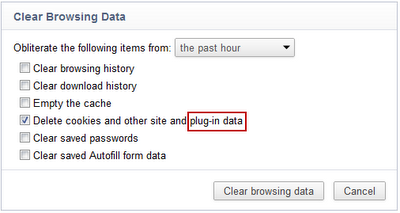Many web users today are aware of browser cookies, and every major browser allows users to view and delete the browser cookies stored on their computer. However, some users may not be aware that many websites use different types of local storage as well, including Adobe Flash Player Local Shared Objects (LSOs), referred to by some people as “Flash cookies.”
In the past, in order to view Flash LSOs and delete them from your computer, you had to visit an online settings application on Adobe’s website. To make local storage data deletion easier, we worked with Adobe and others in the web community to design the NPAPI ClearSiteData API. This API, which Adobe has implemented in Flash Player 10.3, has made it possible to delete Flash LSOs directly from the browser itself.
As of this week’s Chrome Dev channel release, you can delete local plug-in storage data (such as Flash LSOs) from within Chrome by clicking Wrench > Tools > Clear browsing data and selecting “Delete cookies and other site and plug-in data.”
 Above: The chrome://settings/clearBrowserData dialog.
Above: The chrome://settings/clearBrowserData dialog.
“Plug-in data” here refers to client-side data stored by plug-ins that obey the NPAPI ClearSiteData API, such as Flash Player 10.3. You can also configure Chrome’s content settings to clear plug-in data automatically whenever you close the browser.
 Above: The chrome://settings/content dialog.
Above: The chrome://settings/content dialog.
To our knowledge, Adobe Flash Player is currently the only NPAPI plug-in which has implemented support for the NPAPI ClearSiteData API, but we hope other plug-ins will follow suit. We believe providing control over plug-in data directly in the browser creates a better experience for both users and website developers.